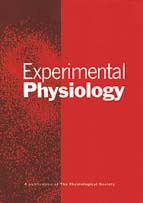Crossref Citations
This article has been cited by the following publications. This list is generated based on data provided by
Crossref.
KOPPO, KATRIEN
JONES, ANDREW M.
VANDEN BOSSCHE, LUC
and
BOUCKAERT, JACQUES
2002.
Effect of prior exercise on &OV0312;O2 slow component is not related to muscle temperature.
Medicine & Science in Sports & Exercise,
Vol. 34,
Issue. 10,
p.
1600.
Fawkner, Samantha G
and
Armstrong, Neil
2003.
Oxygen Uptake Kinetic Response to Exercise in Children.
Sports Medicine,
Vol. 33,
Issue. 9,
p.
651.
Fawkner, Samantha
and
Armstrong, Neil
2004.
Modelling the &Vdot;O2 kinetic response to heavy intensity exercise in children.
Ergonomics,
Vol. 47,
Issue. 14,
p.
1517.
KOLKHORST, FRED W.
REZENDE, ROBERT S.
LEVY, SUSAN S.
and
BUONO, MICHAEL J.
2004.
Effects of Sodium Bicarbonate on &OV0312;O2 Kinetics during Heavy Exercise.
Medicine & Science in Sports & Exercise,
Vol. 36,
Issue. 11,
p.
1895.
HAJOGLOU, AMANDA
FOSTER, CARL
DE KONING, JOS J.
LUCIA, ALEJANDRO
KERNOZEK, THOMAS W.
and
PORCARI, JOHN P.
2005.
Effect of Warm-Up on Cycle Time Trial Performance.
Medicine & Science in Sports & Exercise,
Vol. 37,
Issue. 9,
p.
1608.
Unnithan, Viswanath B.
Baynard, Tracy
Potter, Christopher R.
Barker, Piers
Heffernan, Kevin S.
Kelly, Erin
Yates, Greg
and
Fernhall, Bo
2007.
An Exploratory Study of Cardiac Function and Oxygen Uptake During Cycle Ergometry in Overweight Children.
Obesity,
Vol. 15,
Issue. 11,
p.
2673.
Fitzsimons, Claire
Simpson, Hamish
Young, Archie
and
Greig, Carolyn
2007.
Oxygen uptake kinetics measured at the onset of comfortable self-paced walking in elderly women after hip fracture .
European Journal of Applied Physiology,
Vol. 100,
Issue. 3,
p.
355.
Isaacs, Kristin
Glen, Graham
Mccurdy, Thomas
and
Smith, Luther
2008.
Modeling energy expenditure and oxygen consumption in human exposure models: accounting for fatigue and EPOC.
Journal of Exposure Science & Environmental Epidemiology,
Vol. 18,
Issue. 3,
p.
289.
HETTINGA, FLORENTINA J.
DE KONING, JOS J.
and
FOSTER, CARL
2009.
V˙O2 Response in Supramaximal Cycling Time Trial Exercise of 750 to 4000 m.
Medicine & Science in Sports & Exercise,
Vol. 41,
Issue. 1,
p.
230.
Murias, Juan M.
Spencer, Matthew D.
Kowalchuk, John M.
and
Paterson, Donald H.
2011.
Influence of phase I duration on phase II V̇o2 kinetics parameter estimates in older and young adults.
American Journal of Physiology-Regulatory, Integrative and Comparative Physiology,
Vol. 301,
Issue. 1,
p.
R218.
Spencer, Matthew D.
Murias, Juan M.
Lamb, Heather P.
Kowalchuk, John M.
and
Paterson, Donald H.
2011.
Are the parameters of VO2, heart rate and muscle deoxygenation kinetics affected by serial moderate-intensity exercise transitions in a single day?.
European Journal of Applied Physiology,
Vol. 111,
Issue. 4,
p.
591.
Murias, Juan M.
Spencer, Matthew D.
DeLorey, Darren S.
Gurd, Brendon J.
Kowalchuk, John M.
and
Paterson, Donald H.
2011.
Speeding of V̇o2 kinetics during moderate-intensity exercise subsequent to heavy-intensity exercise is associated with improved local O2 distribution.
Journal of Applied Physiology,
Vol. 111,
Issue. 5,
p.
1410.
Murias, Juan M.
Spencer, Matthew D.
Kowalchuk, John M.
and
Paterson, Donald H.
2011.
Muscle deoxygenation to VO2 relationship differs in young subjects with varying τVO2.
European Journal of Applied Physiology,
Vol. 111,
Issue. 12,
p.
3107.
Reis, Joana F.
Alves, Francisco B.
Bruno, Paula M.
Vleck, Veronica
and
Millet, Gregoire P.
2012.
Effects of aerobic fitness on oxygen uptake kinetics in heavy intensity swimming.
European Journal of Applied Physiology,
Vol. 112,
Issue. 5,
p.
1689.
Spencer, Matthew D.
Murias, Juan M.
Grey, Tyler M.
and
Paterson, Donald H.
2012.
Regulation of V̇o2 kinetics by O2 delivery: insights from acute hypoxia and heavy-intensity priming exercise in young men.
Journal of Applied Physiology,
Vol. 112,
Issue. 6,
p.
1023.
Murias, Juan M.
Spencer, Matthew D.
Pogliaghi, Silvia
and
Paterson, Donald H.
2012.
Noninvasive estimation of microvascular O2 provision during exercise on-transients in healthy young males.
American Journal of Physiology-Regulatory, Integrative and Comparative Physiology,
Vol. 303,
Issue. 8,
p.
R815.
Spencer, Matthew D.
Keir, Daniel A.
Nederveen, Joshua P.
Murias, Juan M.
Kowalchuk, John M.
and
Paterson, Donald H.
2013.
Prolonged moderate-intensity exercise oxygen uptake response following heavy-intensity priming exercise with short- and longer-term recovery.
Applied Physiology, Nutrition, and Metabolism,
Vol. 38,
Issue. 5,
p.
566.
Dogra, Shilpa
Spencer, Matthew D.
Murias, Juan M.
and
Paterson, Donald H.
2013.
Oxygen uptake kinetics in endurance-trained and untrained postmenopausal women.
Applied Physiology, Nutrition, and Metabolism,
Vol. 38,
Issue. 2,
p.
154.
Kubo, Yusuke
and
Nishida, Yuusuke
2013.
Relationships of Pulmonary Oxygen Uptake Kinetics with Skeletal Muscle Fatigue Resistance and Peak Oxygen Uptake in Healthy Young Adults.
Journal of Physical Therapy Science,
Vol. 25,
Issue. 11,
p.
1363.
Spencer, Matthew D.
Murias, Juan M.
Kowalchuk, John M.
and
Paterson, Donald H.
2013.
Effect of moderate-intensity work rate increment on phase II τVO2, functional gain and Δ[HHb].
European Journal of Applied Physiology,
Vol. 113,
Issue. 3,
p.
545.


